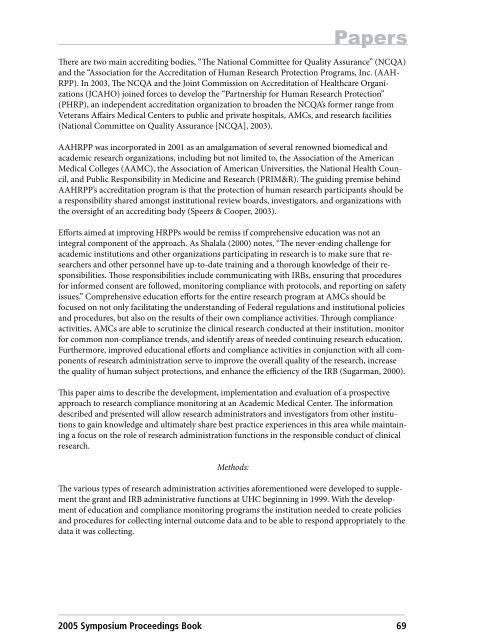The SRA Symposium - College of Medicine
The SRA Symposium - College of Medicine
The SRA Symposium - College of Medicine
Create successful ePaper yourself
Turn your PDF publications into a flip-book with our unique Google optimized e-Paper software.
<strong>The</strong>re are two main accrediting bodies, “<strong>The</strong> National Committee for Quality Assurance” (NCQA)<br />
and the “Association for the Accreditation <strong>of</strong> Human Research Protection Programs, Inc. (AAH-<br />
RPP). In 2003, <strong>The</strong> NCQA and the Joint Commission on Accreditation <strong>of</strong> Healthcare Organizations<br />
(JCAHO) joined forces to develop the “Partnership for Human Research Protection”<br />
(PHRP), an independent accreditation organization to broaden the NCQA’s former range from<br />
Veterans Affairs Medical Centers to public and private hospitals, AMCs, and research facilities<br />
(National Committee on Quality Assurance [NCQA], 2003).<br />
AAHRPP was incorporated in 2001 as an amalgamation <strong>of</strong> several renowned biomedical and<br />
academic research organizations, including but not limited to, the Association <strong>of</strong> the American<br />
Medical <strong>College</strong>s (AAMC), the Association <strong>of</strong> American Universities, the National Health Council,<br />
and Public Responsibility in <strong>Medicine</strong> and Research (PRIM&R). <strong>The</strong> guiding premise behind<br />
AAHRPP’s accreditation program is that the protection <strong>of</strong> human research participants should be<br />
a responsibility shared amongst institutional review boards, investigators, and organizations with<br />
the oversight <strong>of</strong> an accrediting body (Speers & Cooper, 2003).<br />
Efforts aimed at improving HRPPs would be remiss if comprehensive education was not an<br />
integral component <strong>of</strong> the approach. As Shalala (2000) notes, “<strong>The</strong> never-ending challenge for<br />
academic institutions and other organizations participating in research is to make sure that researchers<br />
and other personnel have up-to-date training and a thorough knowledge <strong>of</strong> their responsibilities.<br />
Those responsibilities include communicating with IRBs, ensuring that procedures<br />
for informed consent are followed, monitoring compliance with protocols, and reporting on safety<br />
issues.” Comprehensive education efforts for the entire research program at AMCs should be<br />
focused on not only facilitating the understanding <strong>of</strong> Federal regulations and institutional policies<br />
and procedures, but also on the results <strong>of</strong> their own compliance activities. Through compliance<br />
activities, AMCs are able to scrutinize the clinical research conducted at their institution, monitor<br />
for common non-compliance trends, and identify areas <strong>of</strong> needed continuing research education.<br />
Furthermore, improved educational efforts and compliance activities in conjunction with all components<br />
<strong>of</strong> research administration serve to improve the overall quality <strong>of</strong> the research, increase<br />
the quality <strong>of</strong> human subject protections, and enhance the efficiency <strong>of</strong> the IRB (Sugarman, 2000).<br />
This paper aims to describe the development, implementation and evaluation <strong>of</strong> a prospective<br />
approach to research compliance monitoring at an Academic Medical Center. <strong>The</strong> information<br />
described and presented will allow research administrators and investigators from other institutions<br />
to gain knowledge and ultimately share best practice experiences in this area while maintaining<br />
a focus on the role <strong>of</strong> research administration functions in the responsible conduct <strong>of</strong> clinical<br />
research.<br />
Methods:<br />
Papers<br />
<strong>The</strong> various types <strong>of</strong> research administration activities aforementioned were developed to supplement<br />
the grant and IRB administrative functions at UHC beginning in 1999. With the development<br />
<strong>of</strong> education and compliance monitoring programs the institution needed to create policies<br />
and procedures for collecting internal outcome data and to be able to respond appropriately to the<br />
data it was collecting.<br />
2005 <strong>Symposium</strong> Proceedings Book 69

















